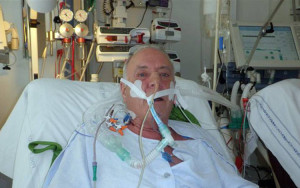Mechanical ventilation without full anaesthesia
Odense University Hospital is one of the few places in the world where patients on mechanical ventilation are not fully anaesthetized. This is only done of course when the medical condition allows it. With this approach, the patients can sit up in a chair and watch TV or listen to the radio, and follow what is going on around them.

OUH is currently investigating the reactions of 700 Scandinavian patients to being awake while they are on mechanical ventilation. (The picture is reproduced with the patient’s permission.)
At most hospitals the world over, seriously ill patients are put into artificial coma when they need help to breathe. In the United States and Germany, these patients are often also strapped to their beds. At OUH however, the patients can sit in a chair in their living room, watch TV and communicate with the staff.
A research project in the Department of Anaesthesiology and Intensive Care follows up on a PhD project that showed that patients on a mechanical ventilator do not need to be fully anaesthetized, but instead can just be given painkillers. This can of course only be done if the patient’s medical condition allows it.
– The first project included 140 patients and we found that – regardless of diagnosis – the patients who were not in artificial coma needed fewer days of respiratory therapy, spent less time on the ward and in general had a shorter hospital stay, explains Professor Palle Toft. The results of the PhD project thus confirmed the beneficial effect of the approach that had been used in the department for several years – an approach that had never been used in hospitals before.
What do the staff and patients think about it?
As part of her PhD, development and quality assurance nurse Eva Lærkner interviewed patients about their experience of being conscious while being in limbo between life and death. And not surprisingly, the responses varied:
– The positive message is that patients are pleased to be able to follow what is going on around them. They know their relatives are there, and they can express themselves through body language, lip reading or writing and can thus communicate their needs and wants, says Eva Lærkner.
“I don’t know what it would have been like to be unconscious, but I am glad that I was awake as I could keep track of what was happening around me. Now it feels like I can remember everything that happened and I would be really sorry to have lost those days in the intensive care department ” (interview with a 50-year-old man)
– On the other hand, it is also hard to know that you have a life-threatening illness and to go in and out of consciousness, and patients react in different ways.
In another of her PhD studies, Eva Lærkner investigated nurses’ experiences while caring for these patients on mechanical ventilation.
– The intensive care nurses expressed a preference for looking after patients who were awake. They get something back when the patient is able to respond to questions and comments. But it is also demanding, because the nurses need to attend to both interpersonal and technical needs, she says.
Does it improve survival?
– Up until 2017 we are digging deeper and conducting a study involving 700 patients from Danish, Norwegian and Swedish hospitals. Half of them will be treated in the traditional way with full anaesthesia and awakening once a day, while the other half will just get painkillers, explains Palle Toft.
The researchers want to test their theory that the group of patients who remain awake will have a better survival rate than the patients in artificial coma. The project will also look at the effect of patient mobilization and stimulation on muscle mass and cognitive function. Finally, researchers will investigate whether the patients get post-traumatic stress later on.
In every other hospital in the world, patients needing mechanical ventilation are always given full anaesthesia to put them into an artificial coma. In for example Germany and the United States, these patients are also often strapped to their beds. Palle Toft points out that one of the aims of the current research is to raise awareness about a treatment that appears to benefit both the patients and the hospital.
Fatcs
+ More about the NONSEDA project
+ Eva Lærkner’s article about looking after intensive care patients who are awake on mechanical ventilation
More information?



